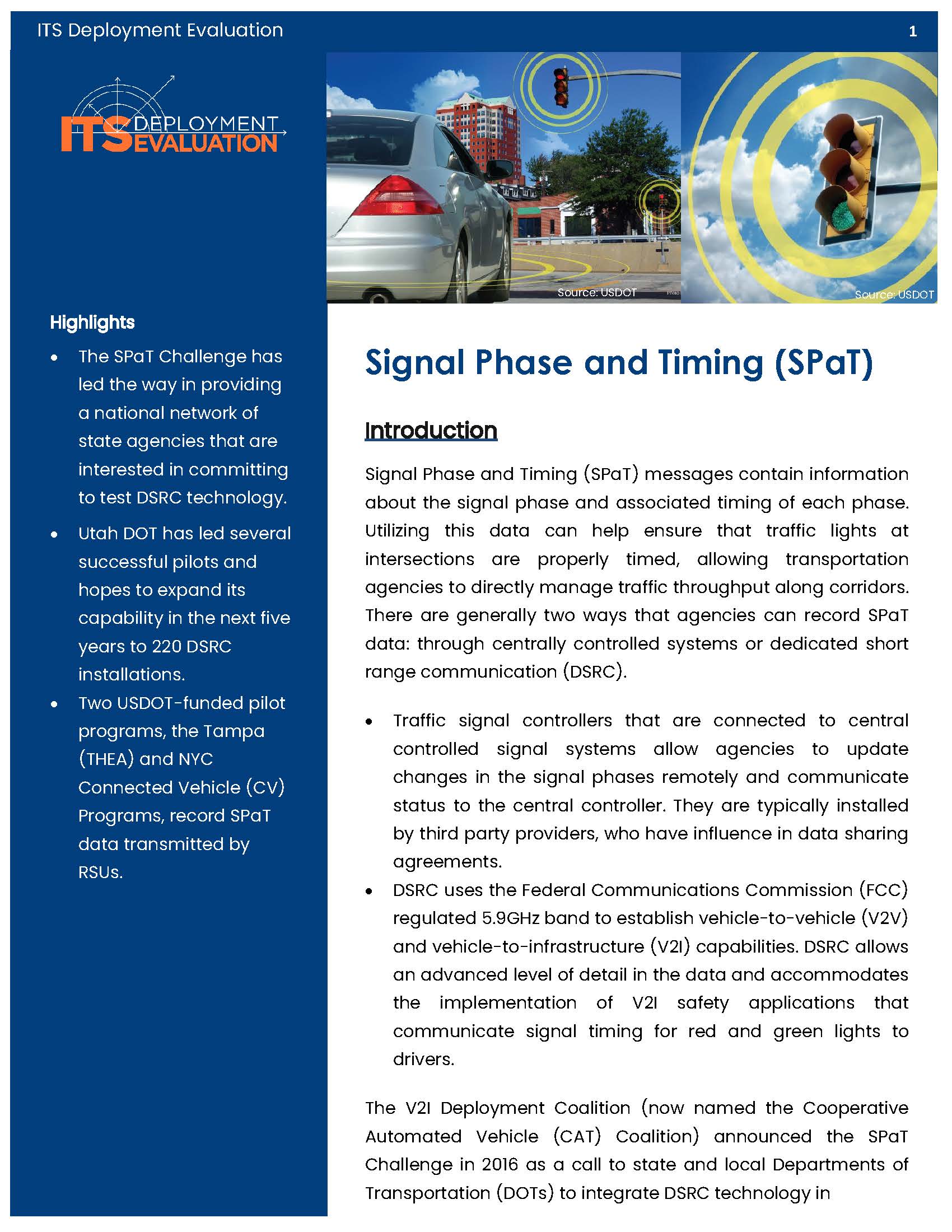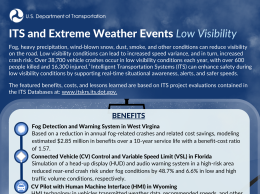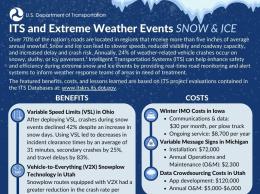Signal Phase and Timing (SPaT)
2020 Executive Briefing
BRIEFING HIGHLIGHTS:
- The SPaT Challenge has led the way in providing a national network of state agencies that are interested in committing to test DSRC technology.
- Utah DOT has led several successful pilots and hopes to expand its capability in the next five years to 220 DSRC installations.
- Two USDOT-funded pilot programs, the Tampa (THEA) and NYC Connected Vehicle (CV) Programs, record SPaT data transmitted by RSUs.
Introduction
Signal Phase and Timing (SPaT) messages contain information about the signal phase and associated timing of each phase. Utilizing this data can help ensure that traffic lights at intersections are properly timed, allowing transportation agencies to directly manage traffic throughput along corridors. There are generally two ways that agencies can record SPaT data: through centrally controlled systems or dedicated short range communication (DSRC).
- Traffic signal controllers that are connected to central controlled signal systems allow agencies to update changes in the signal phases remotely and communicate status to the central controller. They are typically installed by third party providers, who have influence in data sharing agreements.
- DSRC uses the Federal Communications Commission (FCC) regulated 5.9GHz band to establish vehicle-to-vehicle (V2V) and vehicle-to-infrastructure (V2I) capabilities. DSRC allows an advanced level of detail in the data and accommodates the implementation of V2I safety applications that communicate signal timing for red and green lights to drivers.
The V2I Deployment Coalition (now named the Cooperative Automated Vehicle (CAT) Coalition) announced the SPaT Challenge in 2016 as a call to state and local Departments of Transportation (DOTs) to integrate DSRC technology in approximately 20 intersections in all 50 states by 2020. As of early 2020, 26 states have responded to the challenge, with over 2,000 total DSRC signals planned for installation through the end of the year. The Vehicle-to-Infrastructure (V2I) Deployment Coalition, made up of the American Association of State Highway Transportation Officials (AASHTO), the Institute of Transportation Engineers (ITE), and the Intelligent Transportation Society of America (ITS America) has outlined how the SPaT Challenge can serve transportation networks and expand potential for transportation technology development as follows:
- It introduces state and local DOTs to DSRC-based V21 deployment and builds experience in procurement, licensing, installation, and operation.
- It will ensure promotion of future V21 deployments.
- It sends a message of commitment to automobile manufacturers and application developers.

Overall, the challenge provides a framework for DSRC deployment and creates future potential for the expansion of V2I infrastructure in transportation networks across the country.1
Benefits
Develop Safety Features. Safety application developers can create new opportunities to improve vehicle safety at intersections using DSRC technology. Research shows that DSRC has the potential to prevent millions of crashes at intersections (2019-01354). The United States Department of Transportation (USDOT) has field tested DSRC-based V2V and V2I initiatives for buses, including warnings regarding pedestrians in crosswalks and vehicles turning right in front of buses. DSRC functionality has been successful, and there is room to improve safety applications that utilize DSRC (2014-00972).
Prioritize Public Transportation. DSRC technology can adjust green light time. By holding traffic lights on the green phase, the efficiency and reliability of the public transportation network can be improved. This is especially important when buses are running late, as DSRC technology at intersections can help buses get back on schedule by holding green lights (2019-01349).

Reduce Fuel Consumption. SPaT data can support limiting fuel consumption through eco-routing features and Eco-Approach and Departure (EAD) applications. DSRC technology can send SPaT-based notices to drivers about vehicle speed. These messages can limit fuel consumption during deceleration and acceleration and reduce idling and stopping (2019-01355).
Manage Throughput. In addition to minimizing fuel consumption, communicating recommendations on speed adjustments to drivers can also improve overall throughput. Field tests and algorithms of the Safe Green Passage application have revealed a decrease in travel time. However, as traffic increased, travel times and stop delays also increased (2015-01034).
| Agency | SPaT Use | Benefit |
|---|---|---|
| University of Michigan Transportation Research Institute | Used calculations to determine the patterns of vehicle crashes, injuries, and fatalities that would exist without implementation of DSRC. | Safety applications could prevent 7.4 and 8.1 million crashes, if DSRC technology was mandated as of 2019 (2019-01354). |
| Utah Department of Transportation and Utah Transit Authority | Used a schedule-checking module and DSRC radios to provide buses that fell behind schedule with additional green light time in 30 intersections. | The #217 bus route improved reliability by 12% and late bus arrivals were reduced by 40% (2019-01349). |
| University of California- Riverside | Used SPaT messages from six intersections to test fuel emissions for truck acceleration (passing through an intersection) and deceleration (breaking smoothly before a yellow light). | Eco-driving resulted in up to 9% fuel savings in diesel trucks (2019-01391). |
| Partnership between the Harbin Institute of Technology, Delft University, University of Virginia, and FHWA | Used an algorithm-based simulation to test SPaT messages regarding recommended driving speeds to test eco-driving systems and the impact on traffic flow. | Throughput improved by up to nearly 11%, varying based on the saturation of the technology in the simulation (2018-01320). |
Costs
Few agencies have implemented DSRC and SPaT technology on a city-wide scale or larger. Costs can be a barrier for cities to implement on a large scale, so small-scale pilots spurred by the SPaT challenge are currently more common. The Georgia Department of Transportation (GDOT) estimated funding the purchase, installation, configuration, and support for Roadside units (RSUs) that house the DSRC technology for 1,600 intersections would cost $6.64 million (2020-00446). The GDOT also estimated that implementing 600 intersections with RSUs with DSRC technology in Atlanta would cost $2.49 million (2018-00409). On a smaller scale, Seattle estimated that implementing RSUs and technology in 10 intersections would cost between $70K-$80K.
| Location | Estimated cost per intersection |
|---|---|
| Georgia (Statewide) | $4,150 per intersection (1,600 intersections) (2020-00446) |
| Atlanta, GA | $4,150 per intersection (600 intersections) (2018-00409) |
| Seattle, WA | $8,000 per intersection (10 intersections) (2019-00439) |
As shown in Table 2, the cost of the equipment, deployment, and configuration of an RSU can vary according to the scale of the implementation. The GDOT estimate found a consistent price across the various scales of deployment. Seattle’s data show that implementing RSUs on a smaller scale involves higher individual unit costs. Overall, the National Operations Center of Excellence (NOCoE) notes that costs are dependent on what hardware currently exists at intersections, its age, and model. These factors can determine the controller’s ability to send SPaT data and the quality of the data. If SPaT messaging is already possible at an intersection, NOCoE suggests that costs can be as low as $5,000 per intersection. Whereas new installations at an intersection can vary from $15,000 to $50,000.2
Best Practices
Efforts like the SPaT Challenge and the USDOT’s Connected Vehicle (CV) Pilot Program have allowed state and local agencies to develop and share best practices broadly. Additionally, the Federal Highway Administration (FHWA) has developed several documents detailing lessons learned from the federal perspective. The following best practices are collected from several FHWA and state DOT resources.
- Procurement, Approvals, and Permits. Several FHWA reports highlight lessons learned on procurement practices. It has been recommended that procurement personnel be involved with the entire project lifecycle, and that documentation include an approach considering future technology developments and standards (2018-00842). When it comes to equipment procurement, agencies recommend testing vendor equipment with current infrastructure as a part of the vendor selection process and selecting multiple vendors (2019-00855). The ITS Joint Program Office (JPO), NOCoE, and AASHTO regularly publish documentation, public data, peer exchanges, and webinars to share knowledge and experience about the procurement processes.

- Partnerships. There is no one-size-fits-all method to developing partnerships for implementing RSU technology, but some lessons learned have been shared. A 2018 ITS deployment report notes that partnerships with neighboring and overlapping jurisdictions can support a seamless RSU network (2019-00865). The 2018 report on the state of CV Pilot program notes that state DOTs have been integral to vendor selection and FCC licensing, while local universities can provide research and development for CV projects and can support initial testing of CV equipment (2018-00842).
- Future technology and integration concerns. The FHWA recommends that, in the long-term, agencies should expect technology upgrades or equipment replacement with the evolution of communications technology. A NOCoE published report notes that considering the future compatibility of RSU technology is an important consideration, specifically when deciding between RSU units with DSRC or centrally controlled cellular/WIFI capability. NOCoE recommends installing units that have dual capabilities for each, allowing for flexibility in the adoption of specific kinds of RSUs (2019-00900).
- Management of the network. The Transportation Management Center (TMC) plays a big role in keeping the RSU system running. TMCs manage the data collected, including decryption and analysis of SPaT data. The TMC checks on individual system elements, such as the status of the RSUs and the consistency of their communication patterns, making updates and improvements as needed (2018-00845). The TMC also monitors roadway conditions and sends data to RSUs so they can adjust to the needs of the traffic network and influence the timing of corridor signals.

- Security, Data Monitoring, and Standardization. There are several lessons learned noted from state DOTs and the FHWA regarding SPaT data that range from defining data across projects and planning for a data framework.
- The Tampa (THEA) CV Pilot and New York City DOT (NYCDOT) Pilot tested DSRC applications that use SPaT and MAP (intersection geometry) messages to alert drivers of pedestrians in crosswalks. To ensure consistency across applications, THEA and NYCDOT needed to standardize data across their projects. While NYC defined the crosswalk as “the area between the curbs,” THEA included the “sidewalk’s entry/exit point to the crossing” in their definition. To ensure data was reflected across both pilots, THEA adopted NYC’s definition and standardized their SPaT and MAP data accordingly (2018-00844).
- Michigan DOT (MDOT) released a framework for a connected vehicle infrastructure that includes questions agencies should ask themselves and a collection of priorities for enhancing existing infrastructure to support vehicle connectivity. Essentially, DOTs should plan for their desired backhaul communications system, which can be wireless, fiber, or leased communications. MDOT recommends fiber networks that allow agencies to transmit the most amounts of data, while acknowledging that the current fiber network is limited. MDOT also recommends agencies prepare a Data Warehouse Strategic Plan that communicates how to integrate components of the data warehouse across agency departments and lays the groundwork for security procedures. Agencies are also urged to be transparent with the public, stakeholders, and funding providers about data security guidelines such as encryption and scrubbing private data (2018-00839).
Case Study
The Utah Department of Transportation (UDOT) began deploying SPaT technology as early as 2014. They initiated their first DRSC pilot on Redwood avenue in 2018 (see Table 1). The project was a notable commitment to improve bus reliability and an important stepping-stone for UDOT. It gave the agency experience installing RSU units at 24 intersections on an 11-mile route, and eventually expanded to incorporate additional Bus Rapid Transit (BRT) buses, and even snowplows.3 The goals of the pilot were three-fold: establish a DSRC corridor, increase transit reliability, and meet the SPaT challenge.4

The pilot utilized the Multi-Modal Intelligent Traffic Signal System (MMITSS) application, which uses V2I communication to balance signal priority requests from vehicles. Over three years, UDOT installed DSRC equipment on buses and in RSUs at intersections; and programmed traffic signals with fiber backhaul, processors, and signal controllers.5 The deployment’s process of developing and sending SPaT data are as follows:
- The mobile data computer sends data on location, on-time status, and bus occupancy to the Utah Transit Authority server, which communicates the data back to the on-board processor on the bus.
- The on-board unit (OBU) communicates basic safety messages and signal request messages to the RSU and its processor.
- The roadside processor sends data that it received from the OBU to the traffic signal and the Utah DOT Server.
- The signal controller, which directs the patterns of the traffic light, sends SPaT and transit signal priority messages to the RSU, which then sends signal status message back to the OBU, allowing the bus driver to decide whether or not to accelerate or decelerate the bus to safely make the green light.
Findings
The pilot resulted in a 12% increase in transit reliability along the route (6% for the Southbound PM peak and 6% for the Northbound AM peak)4. The findings also show a 40% reduction in late bus arrivals, allowing many buses to gain time during a green light signal using SPaT messaging.
Next Steps
As of 2019, the project included 127 intersections equipped with the infrastructure needed to communicate with buses and trucks6. The Redwood Avenue project improved upon UDOT’s network of RSUs and DSRC technology statewide and expanded their experience and understanding of V2V and V2I capabilities. As part of its “zero fatalities, zero crashes, zero injuries” vision, UDOT plans to implement an additional 220 DSRC installations that can interact with up to 2,000 vehicles.8 The project is being planned in several phases:
- deployment of the technology on the selected roadways and in the selected fleet vehicles;
- development of the software applications that consider the data being collected;
- and development of a cloud-based data analytics, processing, and storage system.8
Under Phase 1, UDOT is first preparing 30 state-owned vehicles to test sensors along 40 selected sections of highway where DSRC technology will be installed9. UDOT’s bus transportation pilot has catapulted them to be a leader in DSRC technology pilots. Their experience will be invaluable as other DOTs consider setting up mid-size pilot projects of their own.
References
- SPaT Challenge Overview, National Operations Center of Excellence. (n.d.). https://transportationops.org/spatchallenge
- Frequently Asked Questions SPAT Challenge; Implementation Guide (2017, October 20). https://transportationops.org/spatchallenge/resources/faq https://www.transportationops.org/spatchallenge/resources/Implementation-Guide
- Fryer, B. (2019, April 15). Utah Dept. of Transportation Adopts Ambitious Plan To Meet Area Growth. ENR Mountain States. https://www.enr.com/articles/46699-utah-dept-of-transportation-adopts-ambitious-plan-to-meet-area-growth
- Leonard, B., & Felice, C. (2019, October 28). PPT. Salt Lake City.
- Leonard, B. (2018, May 2). Utah breaks new ground with connected vehicles. Roads & Bridges. https://www.roadsbridges.com/strong-signal
- Descant, S. (2019, June 28). Utah Grows Connected Vehicle Work with Panasonic Partnership. Government Technology. https://www.govtech.com/products/Utah-Grows-Connected-Vehicle-Work-with-Panasonic-Partnership.html
- Utah DOT and Panasonic get connected. (2019, August 30). https://www.itsinternational.com/its7/feature/utah-dot-and-panasonic-get-connected
- Davidson, L. (2019, June 25). Imagine a system that allows cars, roads and signals all to ‘talk’ to one another to prevent wrecks. UDOT signs $50M deal to help develop it. The Salt Lake Tribune. https://www.sltrib.com/news/politics/2019/06/25/imagine-system-that/



